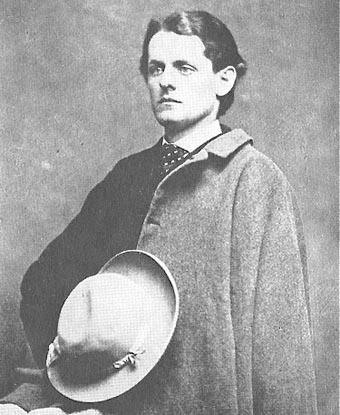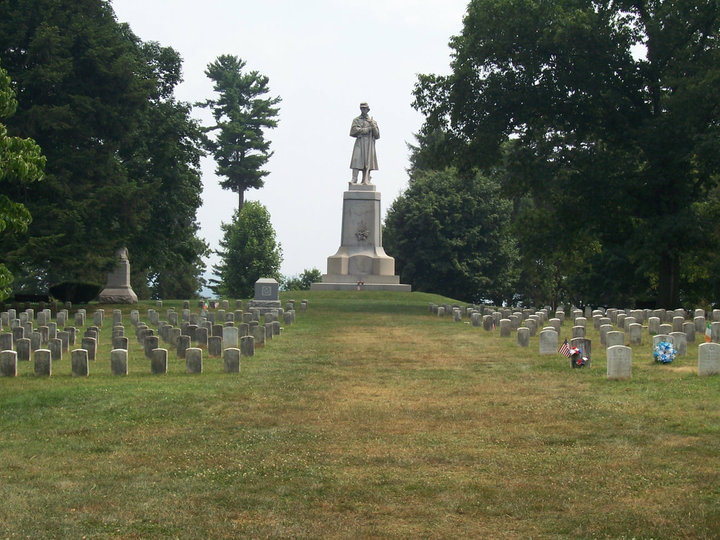McClellan’s Memorial Day Visit to Antietam
“Only once a year, the comrades of the Grand Army march in sad procession to place flowers on the graves of those who died, side by side with the living, in defence of their country and their homes. This is the only public exhibition of of the veterans of the Grand Army.” So wrote the Boston Herald‘s editor in 1885, twenty years after the Civil War’s conclusion.

Memorial Day was, by then, a large American commemoration, something the press covered widely. Veterans across the country gathered in a spirit of remembrance for their dead comrades.
Sharpsburg, Maryland’s citizens greeted Memorial Day every year with reverence. Every day, the graves of 4,776 Union soldiers looked down on their quiet town. The stories of what they experienced on Wednesday, September 17, 1862, could never be silenced or forgotten.
Civilians gathered each Memorial Day inside the stone walls of Antietam National Cemetery to pay their respects. The keynote speaker for the 1885 ceremony drew great attention, and brought throngs of people to the burying ground in Sharpsburg.
George B. McClellan lived a private life following his exit from the Civil War. After a failed 1864 run for President, McClellan spent the duration of the war in Europe. He returned to the public eye as New Jersey’s governor from 1878-1881 before again secluding his life. By 1885, McClellan aged 58 years.

At the behest of former “Stonewall” Jackson staffer Henry Kyd Douglas, McClellan accepted an invitation to be the keynote speaker at the 1885 Memorial Day Commemoration in Sharpsburg. The general and his entourage reached Hagerstown to a glowing reception on Friday morning, May 29. The festivities lasted throughout the rainy day into the night.

Overcast skies hung over western Maryland the next day. On Saturday morning, marching bands and aging veterans accompanied McClellan to the railroad. A special car brought him along the rails and, a short while later, he disembarked at the west end of Sharpsburg.
Towering oak trees hovered above the entourage that entered the town, and the former Union commander at Antietam first made his way to the battlefield. He had not set foot on this ground since 1862. The general’s party explored the northern area of the field, pausing to look at the Dunker Church before stepping into the Bloody Lane. The battlefield 23 years later stood in stark contrast to how McClellan left it in September 1862. Douglas and McClellan spoke to one another in jest as they toured the field. Century Magazine‘s Robert Underwood Johnson also tagged along with the general, armed with a sketchpad to create scenes meant to accompany McClellan’s upcoming article on the Battle of Antietam.

Several hours of battlefield tromping ended and McClellan reached the National Cemetery by noon. He ascended the tower of the Cemetery Lodge, pointing out the particulars of the battlefield to those there with him. A hurried tour of the cemetery followed. One wonders if, while walking that hallowed ground, McClellan paused to visit one of his own kin buried there–Harrison White of the 28th Pennsylvania, the general’s cousin, mortally wounded at Antietam.
The Memorial Day ceremony commenced at 1 pm in front of the cemetery’s impressive Private Soldier Monument–a 250-ton behemoth towering 44 feet above the cemetery floor. After the service wrapped up there, the attendees made their way to the rostrum. McClellan and his party climbed onto the platform, the old general pulled his speech from his pocket, and began fitting the solemn occasion into words.

“[P]utting behind us all the strife and the rancor and bitterness of that conflict,” he began, with an eye towards the Confederate veterans in the crowd, “and burying in oblivion the animosities of that trying period of our Country’s history, we have met here to-day to do honor to the men, who sleep in this beautiful spot, after having given their lives as a sacrifice for the preservation of their Country. They died not in vain, [but] for the Republic,” he proclaimed.
George McClellan’s speech touched upon many topics–the motivations of the war, the nature of the two armies that fought at Antietam, and a final prayer “that our great Union may never again be endangered…”
The general’s Memorial Day address was no Gettysburg Address. It received mixed results throughout the papers. One praising newspaper called the speech “a scholarly production.” Still another termed it “more of an apology for the part he had taken in the war…than anything else.” Either way, the audience greeted the general’s speech with “several rousing cheers…”
Following the speech, the throngs of attendees broke up. McClellan did not linger long in Sharpsburg, though “an elegant champagne lunch” briefly occupied him. McClellan’s party then made its way back to the train station, boarded the cars, and left Sharpsburg for the last time.
One eyewitness claimed George B. McClellan wore “the same faded blue uniform which he had worn when he commanded at the Battle of Antietam” in September 1862. That uniform could never lose its marks from the battlefield–the smell of gunpowder or its dust-grimed tint. The battlefield that McClellan saw in 1885 changed dramatically from the one he saw in 1862. Even those 23 years could not wipe away the scars of the fight, however. Those headstones over which McClellan spoke, marking the graves of the Union dead, are enough of a permanent mark on the landscape to never let one forget the terrible storms this nation endured in war.
Bibliography:
“Another Memorial Day,” Herald and Torch Light (Hagerstown, MD), June 4, 1885.
“Antietam Battlefield,” Baltimore Sun, June 1, 1885.
John W. Schildt, “These Honored Dead,” (Brunswick, MD: E. Graphics, 2016), 66-7, 102-7.
“The Dead Heroes,” Boston Herald, May 31, 1885.
General McClellan died five months after this visit to Antietam in October 1885. Are there any photos of his visit? I am not aware of any.
Todd, unfortunately I have never seen one, though I would love to know if there are any.
He was a relatively young man when he died; what in fact was the cause of his death?
Correct, he was only 58 when he passed away. He ended up dying of heart disease, which he suffered through six weeks of before passing.
58 is not young for the 1880s. Most of these generals were dying in their late 50s/early 60s.
does anyone have a copy of the entire speech McClellan made that day in 1885– i would like to read all his remarks– not just a summary as set out above ; If so – please post it & email me a copy please ;